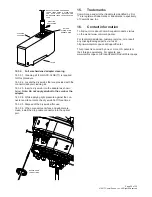
Page 25 of 29
© 2017 CommScope, Inc. All Rights Reserved
13.2.4. Cable testing
Injecting red light into the black capped port(s) when the
terminal tail HMFOC connector is plugged back into itself
via the green capped HMFOC on the body, will allow red
light to travel through all fiber in the assembly to the red
capped reverse port.
Using an OTDR in this fashion will allow the technician to
see through all fiber and connections of the cable
assembly in one trace (best results when connected to
the reverse port).
13.2.5. Splitter Performance
Splitter performance can only be tested as part of the
terminal assembly. It will be a combination of splitter loss,
connector losses (2), and an integral splice. All black
dust cap ports on a terminal* shall have similar readings
in relation to their shared input fiber. See loss tables.
* Index only terminals are excluded as they do not have built in splitters.
13.3. Trouble Shooting
13.3.1. Decision making
• Start at the ONT and work upstream.
• Confirm adjacent ports on terminals are experiencing
same trouble.
• Determine status of adjacent terminals
• Understand the cable leads and their counts.
• Do not disconnect multi fiber connectors until you can
physically see its other end or damage.
13.2. Bench Testing
13.2.1. Primary port verification
Injecting red light into black dust cap service ports will
disperse red light in the female (non-pinned) HMFOC
connector on the tail of the terminals.
13.2.2. Reverse port verification
Injecting red light into red cap reverse ports will disperse
red light in the male (pinned) HMFOC connector on the
body of the terminal body.
13.2.3. Branching port verification
Injecting red light into the blue cap HMFOC port will
disperse red light in the female (non-pinned) HMFOC
connector on the terminal tail.



















